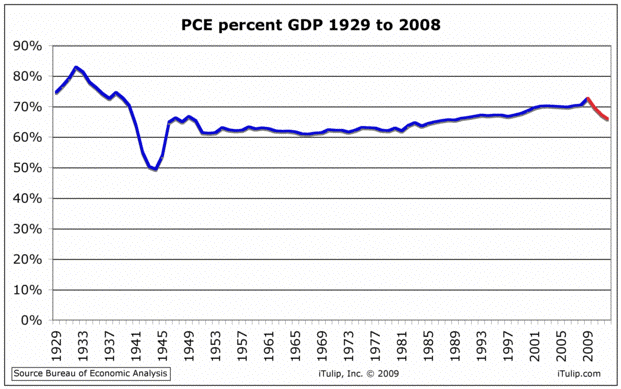Reality is setting in? I guess it qualifies as their flow of funds preview.
On Borrowed Time: Consumer-Led Recovery
By MARK GONGLOFF
June 9, 2009
You don't say!!!!
p.s. Mark is actively replying to comments attached to this article
On Borrowed Time: Consumer-Led Recovery
By MARK GONGLOFF
June 9, 2009
Before pricing in a rapid economic recovery, investors might consider the fundamentals of the economy's workhorse -- the U.S. consumer.
Despite recent frugality, consumers have barely dented their debt load. The Federal Reserve will offer a fresh peek at that mountain on Thursday, when it releases its "flow of funds" data for the first quarter.
[..]
Money is easy again, but unemployment is far higher and wage growth slower than at any time during the 2001 recession.
Households have also now suffered the bursting of two bubbles -- housing and stocks -- carving $12.9 trillion from their net worth since the second quarter of 2007. The recent market rally should bolster household balance sheets, the flow of funds data might show. But real estate is still the biggest household asset, at 36% of net worth, and prices haven't stopped falling.
[..]
Credit should improve, but the era of easy credit is over, suggesting household debt could fall closer to a mere 100% of disposable income. That could sap at least $3 trillion in household borrowing from the economy -- hardly a recipe for a V-shaped recovery.
Despite recent frugality, consumers have barely dented their debt load. The Federal Reserve will offer a fresh peek at that mountain on Thursday, when it releases its "flow of funds" data for the first quarter.
[..]
Money is easy again, but unemployment is far higher and wage growth slower than at any time during the 2001 recession.
Households have also now suffered the bursting of two bubbles -- housing and stocks -- carving $12.9 trillion from their net worth since the second quarter of 2007. The recent market rally should bolster household balance sheets, the flow of funds data might show. But real estate is still the biggest household asset, at 36% of net worth, and prices haven't stopped falling.
[..]
Credit should improve, but the era of easy credit is over, suggesting household debt could fall closer to a mere 100% of disposable income. That could sap at least $3 trillion in household borrowing from the economy -- hardly a recipe for a V-shaped recovery.
p.s. Mark is actively replying to comments attached to this article


Comment